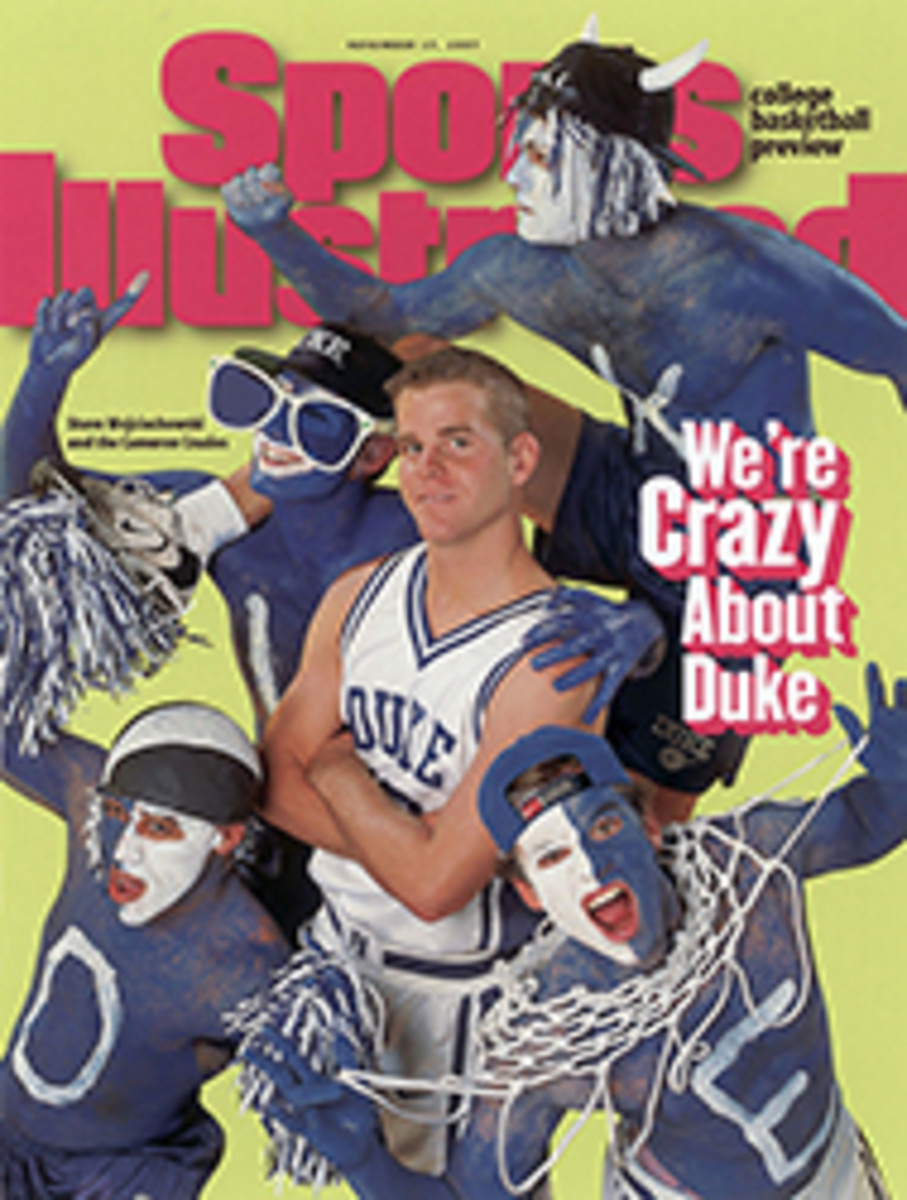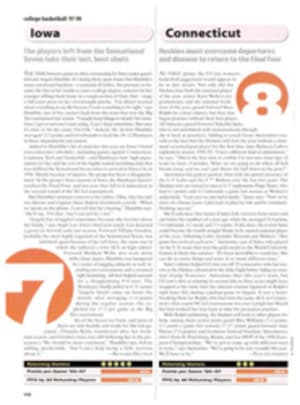
COMPETENCE IS NOT REQUIRED IF YOUR FANTASY IS TO RACE ON AN AMERICA'S CUP YACHT, CATCH A PLANE TO ST. MAARTEN
Sailing off the coast of St. Maarten on Dennis Conner's Stars &
Stripes '87 last spring, I was struck repeatedly by one fact: I
was sailing off the coast of St. Maarten on Dennis Conner's
Stars & Stripes '87.
I would like to tell you that Dennis and I are tight, and that I
was in the Caribbean helping to wring a few extra knots from his
multimillion-dollar vessel. The truth is that Conner is a
stranger to me, he was nowhere in sight that day, and I know
nothing about sailing. Anyone with the means to get to St.
Maarten can do what I did--serve as a race-crew member aboard
the boat that won the America's Cup in 1987.
For $60 to $70, a traveler can sign up for the 12 Metre
Challenge, voted the "top shore excursion" by Caribbean cruise
ships. Cutting across the bluer-than-blue waters of Great Bay,
off the coast of Philipsburg, it's easy to understand the vote.
Out on the water on a perfect afternoon, I'm tempted to kick
back, prop up my feet and enjoy the ride. But that's no way to
win a sailboat race.
Make no mistake, the 12 Metre Challenge is a race. The idea is
for the novice sailors on Stars & Stripes '87 to beat the
novices on Canada II, another former America's Cup entry. Twenty
minutes into the race, my group is well behind. I know Conner
would not like this, so I snap out of my reverie and focus on
the task at hand.
The voice of the first mate cuts through the small talk on
board: "Primary grinders, stand by." Gripping the handles of one
of the winchlike grinders, I wait for my order.
"First gear, go!"
"Second gear, go!"
"Third gear, go!"
At each command, I and three other grinders crank for all we're
worth. Sailing line whizzes by our bodies at 80 mph, and when it
catches we feel the pull in our shoulders. Without awaiting the
next order, we crank the other way.
We are tacking, turning across the wind, and there's all kinds
of commotion. The genoa sail thunders as it fills with wind. A
boom swings from side to side. Noisy sailing gear does whatever
noisy sailing gear is supposed to do. The boat responds like a
sports car. It squats on the water and banks at what seems like
a 45-degree angle. Spray flies as Stars & Stripes '87 rights
herself.
The news from our captain, a South African professional racer
named Grant, is good. "We're gaining on them," he says.
Let's face it, America's Cup sailing is not the most accessible
sport in the world. Most people never get within two tax
brackets of sailing an America's Cup yacht. That's part of the
charm of the 12 Metre Challenge, the brainchild of British
businessman and sailing enthusiast Colin Percy. The 59-year-old
Percy was living in Oakville in Ontario when the stress of
running three companies caught up with him in 1988. His doctor
put it to him succinctly: "You're going to be another statistic,
and your wife is going to be a rich widow."
So Percy chucked it all, and in 1989 he and his wife, Jill,
moved to St. Maarten, the Dutch half of a 33-square-mile island
that the Netherlands shares with France. (The French part is
known as St. Martin.) Looking around for something to do, he
came up with the idea of offering tourists the thrill of a ride
on a 12-meter yacht, the type used in the America's Cup for
three decades, until 1987. Then he decided to get a second boat
and to stage races. He started in '89 with a pair of Canadian
boats, Canada II and True North, which he bought from Canada's
Challenge for the America's Cup. He also bought the unfinished
True North IV, which he had finished in St. Maarten.
The Conner connection came in 1994, when Percy met the famed
racer at a party for the New York Yacht Club in Newport. Conner,
who had heard about Percy's St. Maarten business, said, "You're
the guy with the Canadian 12s." The two men hit it off. Percy
had intended to talk to Conner about acquiring Stars & Stripes
'86, which was rumored to be for sale. But, emboldened, he asked
about '87.
To Percy's surprise, Conner agreed to lease, and eventually
sell, him the boat that had redeemed Conner in the eyes of the
sailing establishment. The U.S. had ruled the America's Cup for
132 years, until 1983, when Conner lost the Cup to an Australian
syndicate. Four years later, at the helm of Stars & Stripes '87,
he got the trophy back.
That was the last America's Cup in which traditional 12-meter
boats were used. Now Conner's old boat is the star of Percy's
daily regattas. There are five boats in all, up to eight races
per day during the peak winter season (late October to late
April), with 22 professional sailors to help crew and maintain
the boats. Percy's marina is located in downtown Philipsburg,
the bustling capital of the Dutch side of the island.
"This is the only place in the world you can do this," Percy
says. Sailing conditions in the eastern Caribbean are almost
always good. More important, St. Maarten doesn't spoil the fun
with too many regulations. Percy considered taking his 12s to
St. Croix, in the U.S. Virgin Islands, or to Key West. But the
U.S. Coast Guard would have required the boats to be equipped
with diesel engines and to be modified extensively for passenger
safety. In St. Maarten, Percy was obliged to make relatively few
modifications to the boats. The sails are slightly reduced in
size to keep the boat more upright on turns--and lifelines have
been added around the deck. Otherwise the boats are as they were
in America's Cup competition--except now they are open to the
landlubbing masses. About 85% of the people who participate in
the 12 Metre Challenge are nonsailors. That includes me.
The race, which takes about an hour over a straight "windward
leeward" course, starts out much like a pickup basketball game.
On a sunny morning 72 of us stand on a dock, listening to an
affable staff member give a brief history of America's Cup
racing. Four "captains" are selected from the group, and each is
told to choose a crew of 12 to 18 members. (Each boat will also
have a professional captain and two professional crew members to
guide and monitor safety.) The primary need is for large, bulky
types to operate the boat's grinders. After teams are chosen, a
tender takes us into the bay, where we meet up with the boats.
On board we get a quick sailing lesson from the professional
crew members. There are jobs requiring brains--trimming the
mainsail, for example--and those requiring brawn. Some jobs,
like the timekeeper's, require little more than enjoying the ride.
I want the full experience, so I volunteer to grind. It's not
difficult at first, and maybe that's why we fall behind Canada
II. Our professional captain tells us our problem is "bad air."
Our opponents are staying between us and the wind, dumping slow,
no-account air on our sails. We need good air. We need to
outmaneuver Canada II. So on the fourth and final leg we zigzag.
The idea is to steal the wind from our adversaries, who are
smart enough to respond to our every move.
It's grueling work. After grinding nonstop for 10 minutes, I
have new respect for the strength of America's Cup crew members.
Although we narrow the gap, as the finish line approaches it's
obvious we won't catch our opponents. "We were out-tacking them,
it was just a matter of [running out of] time," our first mate
says.
With the race over, out come bottled water, soft drinks and
beer. The ride back to the tender is relaxing and pleasant.
Still, I can't help thinking of an oft-told story from the first
America's Cup challenge, in 1851. In that race, around the Isle
of Wight, the upstart challenger America trounced a slew of
Britain's finest sailing vessels. Queen Victoria was watching.
She asked an attendant which boat had won and was told it was
the U.S. vessel. The queen then asked which boat was second.
"Your Majesty, there is no second," came the reply.
Sorry, Dennis.
Ed Miller is a sportswriter for The Virginian-Pilot in Norfolk.
COLOR PHOTO: PHOTOGRAPHS BY DAVID BERGMAN [Boat Stars & Stripes '87 in race with another boat]
COLOR PHOTO: PHOTOGRAPHS BY DAVID BERGMAN The pride of Percy's five-boat fleet is Stars & Stripes '87, which won the Cup for the U.S. 10 years ago. [Colin Percy sitting on deck of boat Stars & Stripes '87]

